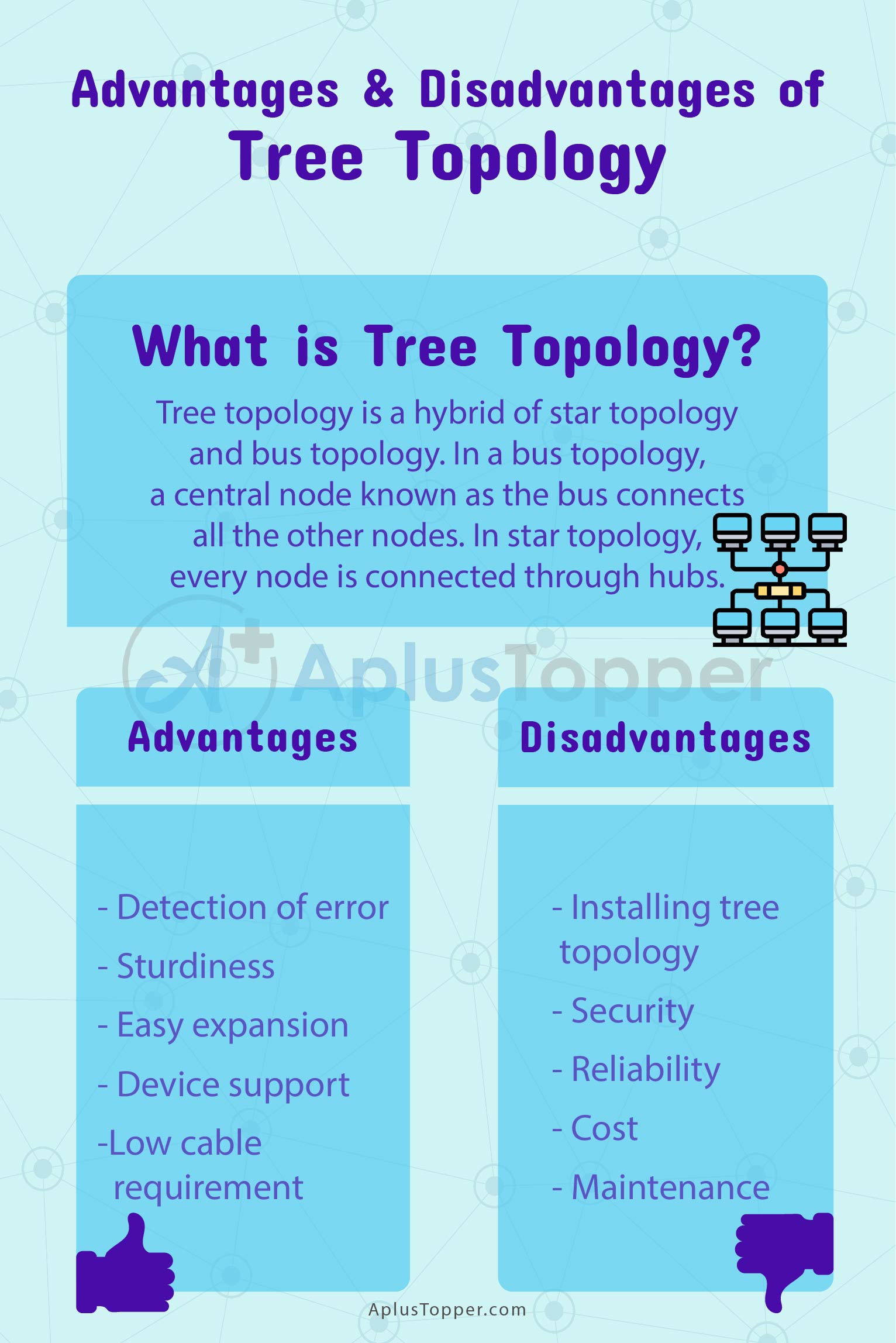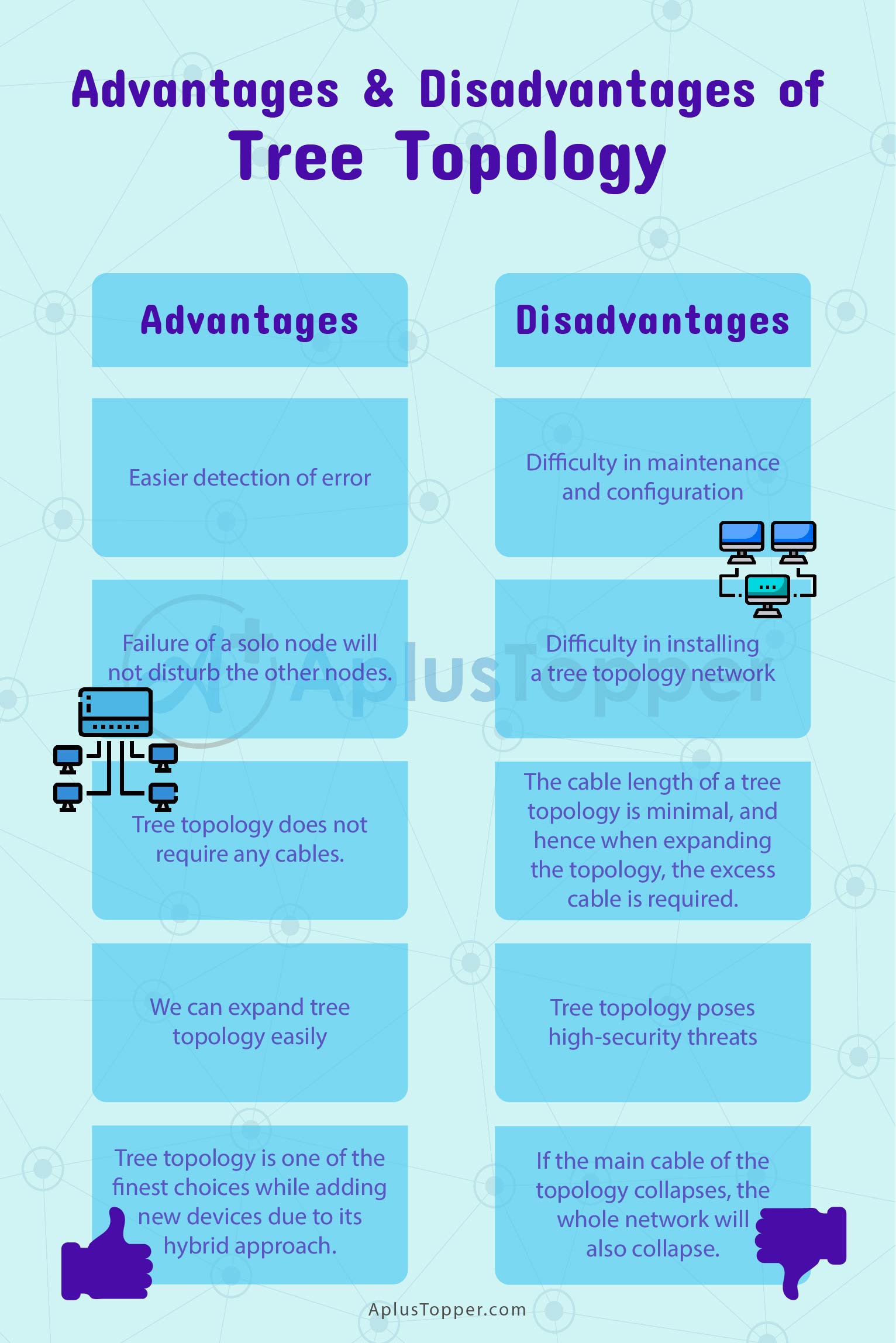Tree Topology Advantages and Disadvantages: Tree topology, also known as Bus-star topology, incorporates the elements of both bus topology as well as a star topology. Tree topology is a network that is not commonly used, but when a combination of scalability or hierarchical setup is required between two networks, this topology is used. The structure of a tree topology is quite different from others since it resembles a tree, and hence it is named as such. The central node of this topology acts as a trunk for the network, and it has nodes extending outwards just like branches of a tree. In tree topology, between any two nodes on the network, the only route is seen. The connection pattern resembles a tree whose branches spring from only one root.
Students can also find more Advantages and Disadvantages articles on events, persons, sports, technology, and many more.
What is Tree Topology? Advantages and Disadvantages of Tree Topology 2022
Tree topology is a hybrid of star topology and bus topology. In a bus topology, a central node known as the bus connects all the other nodes. In star topology, every node is connected through hubs. Tree topology is an expansion of these two topologies, and hence it is also known as an expanded star topology.
In this topology, between any two connected nodes, there is an existence of only one connection. Since two nodes have a mutual relationship, tree topologies create a parent and child hierarchy. In tree topology, all the nodes of computers are connected through a central node forming a hierarchical structure. Hence it is known as hierarchical topology. It is one of the simplest topologies.
Tree topologies are reliable and flexible. For the expansion of this network, one has to connect an extra hub and cables. We can connect tree topology networks to large areas as well. One can click as many servers as they want to the network. When a computer transmits any data, it will get broadcasted in the hub, and then the hub will convey the message to the designated computer.
- Advantages of Tree Topology
- Disadvantages of Tree Topology
- Comparison Table for the Advantages and Disadvantages of Tree Topology
- FAQs on the Pros and Cons of Tree Topology

Advantages of Tree Topology
- Detection of error: In a tree topology, error detection becomes more accessible. All the nodes in this topology are connected through the central hub. The hub can easily detect the node with error since all the information transmitted through the nodes passes through the hub. The node which has a mistake can be easily replaced by replacing the faulty node.
- Sturdiness: In tree topology, if a single node gets defected, it will not affect the other nodes. The entire tree topology network is based on the main backbone cable. Hence, the failure of one node will not affect the other nodes, and the other nodes will continue to function regularly. The removal of any node does not affect the performance of the network.
- Easy expansion: The expansion of tree topology is a straightforward method. It can be expanded even if there is no space. Since this topology follows a hierarchy pattern, many secondary nodes can be attached to it without any issue. As long as enough hubs and cables are available, the expansion won’t be a problem.
- Device support: While adding new devices, one of the best considerable options is a tree topology. Due to its hybrid approach, various manufacturers support this network. It also allows the manufacturers to easily access the devices connected to the network for maintenance and other work.
- Low cable requirement: Installation of a tree topology does not require any cables. There is the existence of a single cable that acts as the backbone of the network, and it runs joint for all the segments of the network. Every tree network is allocated with a point to point wiring. This point-to-point wiring in the network ensures high bandwidth and low latency.
Disadvantages of Tree Topology
- Installing tree topology: The uses of tree topology are limited due to its difficult installation process. Tree topology includes the functions of both bus and star topology. Hence, the cabling requirement of a tree topology is massive. Due to this reason, the process of installing this topology becomes expensive and difficult to handle.
- Security: The security of tree topology is extremely weak. In tree topology, all the computers are interconnected with each other. As a result, any computer within the network can access the data that passes through the network. Therefore, if a hacker somehow manages to take over a single workstation, they can quickly access all the data, and hence the whole network is compromised.
- Reliability: The backbone cable of the tree topology is the main cable on which the entire network depends. If the backbone cable gets defected and fails, then the whole network will collapse. The point where the failure occurs also decides the level of loss. If the damage is restricted before a specific branch, all the segments related to that branch will face problems while functioning. On the other hand, the components which are not associated with it will continue to work usually.
- Cost: The cable length of a tree topology is also an essential factor. While creating the point-to-point connection in tree topology, the cable length is limited to a certain point by default. This limitation later causes trouble since it makes it challenging to get wired. Regardless of this, there will be high wiring requirements if the network needs expansion, which will increase the total cost.
- Maintenance: Maintenance and configuration of tree topology become difficult due to its large size. A lot of time is taken up for managing point-to-point connections, individual star networks, and identification of errors. This is amongst one of the major reasons why large organizations less prefer tree topology.

Comparison Table for Advantages and Disadvantages of Tree Topology
| Advantages | Disadvantages |
| Easier detection of error | Difficulty in maintenance and configuration |
| Failure of a solo node will not disturb the other nodes. | Difficulty in installing a tree topology network |
| Tree topology does not require any cables. | The cable length of a tree topology is minimal, and hence when expanding the topology, the excess cable is required, which results in increasing overall expense. |
| We can expand tree topology easily | Tree topology poses high-security threats |
| Tree topology is one of the finest choices while adding new devices due to its hybrid approach. | If the main cable of the topology collapses, the whole network will also collapse. |

FAQ’s on Pros and Cons of Tree Topology
Question 1.
Tree topologies are used for what?
Answer:
The structure of a tree topology is different from other topologies. The nodes connected to it resembles the branches of a tree. This topology is frequently used in a corporate network to arrange their computers or organize their database information.
Question 2.
Why is tree topology less preferred by large organizations?
Answer:
Large organizations less prefer tree topology due to its complex maintenance and configuration process. Maintaining a tree topology takes up a lot of time. Managing the identification of errors, point-to-point connections, or individual star networks is very time-consuming.
Question 3.
Which protocol is used by tree topology?
Answer:
The Ethernet protocol uses the tree topology.
Question 4.
Which cable is used by tree topology?
Answer:
Twisted pair co-axial cable is used by tree topology.
